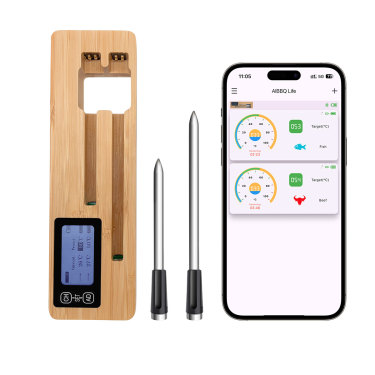Digital Meat Thermometer Guide

# Digital Meat Thermometer Guide
## Introduction to Digital Meat Thermometers
A digital meat thermometer is an essential tool for any home cook or professional chef. Unlike traditional analog thermometers, digital versions provide quick and accurate temperature readings, ensuring your meat is cooked to perfection every time.
## Why Use a Digital Meat Thermometer?
Keyword: digital meat thermometer
Using a digital meat thermometer offers several advantages:
– **Accuracy**: Digital thermometers provide precise temperature readings, reducing the risk of undercooked or overcooked meat.
– **Speed**: Most digital models deliver results in seconds, saving you time in the kitchen.
– **Ease of Use**: Clear digital displays make it simple to read temperatures, even for beginners.
– **Versatility**: Many digital meat thermometers can be used for various types of meat, as well as other foods like baked goods and liquids.
## Types of Digital Meat Thermometers
There are several types of digital meat thermometers available, each suited for different cooking needs:
### Instant-Read Thermometers
These thermometers provide quick temperature readings and are ideal for checking the doneness of meat during cooking. Simply insert the probe into the meat, and the temperature will display within seconds.
### Leave-In Thermometers
Leave-in thermometers are designed to remain in the meat while it cooks. They often come with a probe that connects to a base unit outside the oven, allowing you to monitor the temperature without opening the oven door.
### Wireless Thermometers
Wireless digital meat thermometers use Bluetooth or Wi-Fi to send temperature readings to your smartphone or other devices. This is especially useful for grilling or smoking, where you can monitor temperatures from a distance.
## How to Use a Digital Meat Thermometer
Using a digital meat thermometer correctly ensures accurate results:
1. **Insert the Probe**: Place the probe into the thickest part of the meat, avoiding bones or fat.
2. **Wait for the Reading**: For instant-read thermometers, wait a few seconds until the temperature stabilizes. For leave-in models, monitor the temperature as the meat cooks.
3. **Check the Temperature**: Compare the reading to recommended safe cooking temperatures for the type of meat you’re preparing.
4. **Clean the Thermometer**: Always clean the probe after use to maintain hygiene.
## Recommended Safe Cooking Temperatures
Here are the USDA-recommended internal temperatures for common meats:
– **Beef, Pork, Lamb, and Veal (steaks, roasts, chops)**: 145°F (63°C) with a 3-minute rest time
– **Ground Meats**: 160°F (71°C)
– **Poultry (whole, pieces, or ground)**: 165°F (74°C)
– **Fish**: 145°F (63°C)
## Tips for Choosing the Best Digital Meat Thermometer
When selecting a digital meat thermometer, consider the following factors:
– **Accuracy**: Look for models with a high degree of accuracy (±1°F or better).
– **Response Time**: Faster response times are more convenient, especially for quick-cooking meats.
– **Temperature Range**: Ensure the thermometer covers the range needed for your cooking (typically 32°F to 572°F or 0°C to 300°C).
– **Durability**: Choose a thermometer with a sturdy probe and waterproof design if you plan to use it frequently.
– **Ease of Cleaning**: Removable probes or dishwasher-safe models are easier to maintain.
## Maintaining Your Digital Meat Thermometer
Proper care extends the life of your thermometer:
– **Clean After Each Use**: Wipe the probe with a damp cloth or wash it with warm, soapy water.
– **Avoid Submerging the Display**: Unless the thermometer is waterproof, keep the display unit away from water.
– **Store Properly**: Keep the thermometer in a dry, safe place to prevent damage to the probe or display.
– **Cal